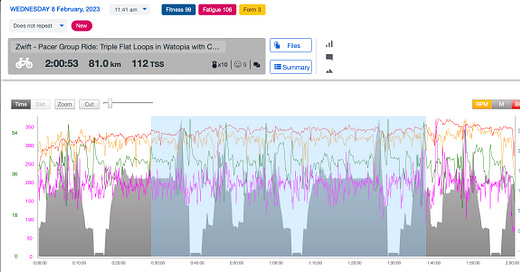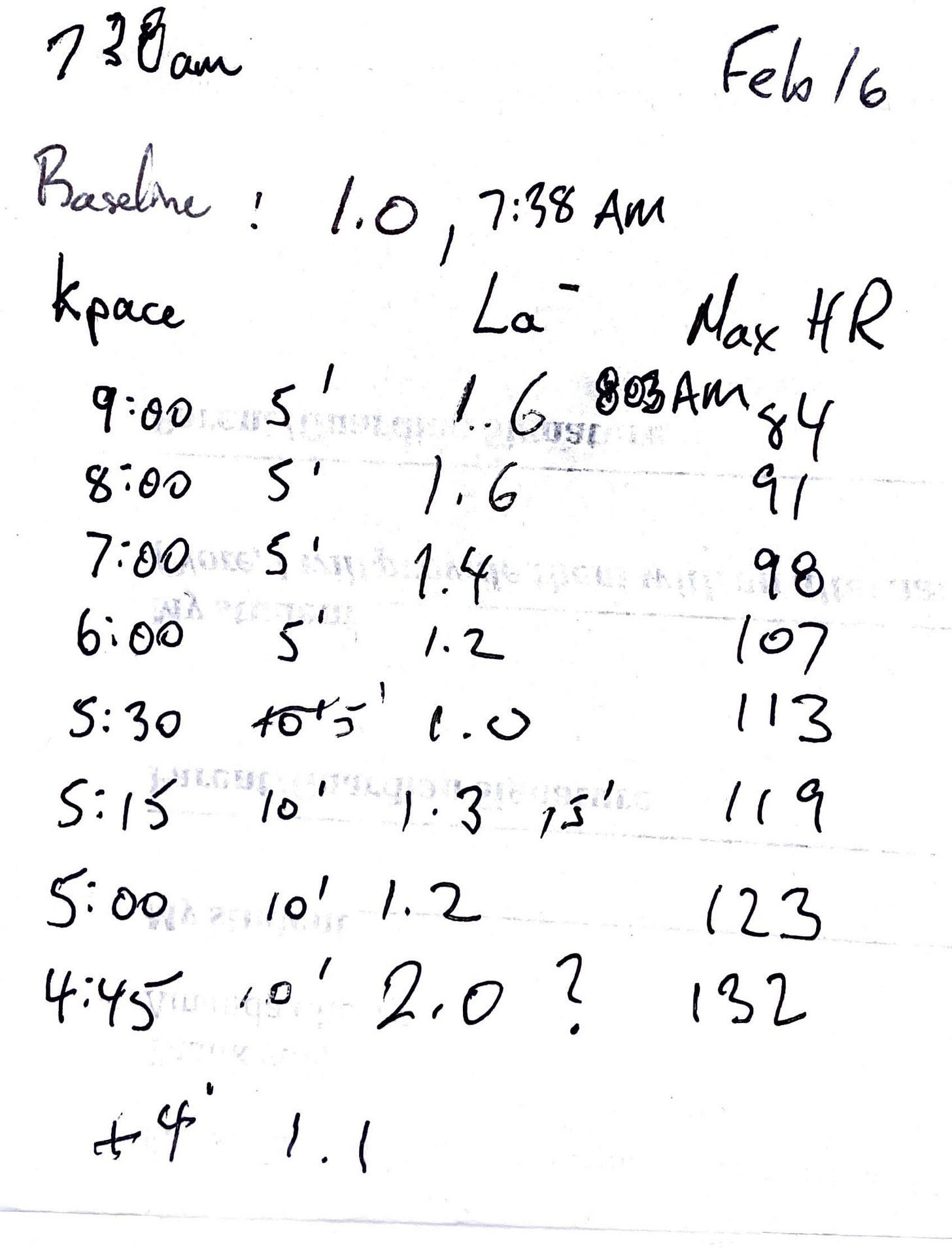The Importance of Submax Benchmarking
How To Confirm Your Zones and Better Design Your Training
Your should do the majority of your training around aerobic threshold (Zone 1, Zone 2, Moderate Domain, Green Zone).
The #1 error athletes make is aiming their endurance training too high.
The #2 error is inappropriate warm-up.
What follows is a two-step protocol that will ensure you are on target and training properly.
I use these Submax Benchmarking because:
Easily Repeated
Teaches Warm-Up
Improves Submax Economy
Actionable Insights
Track My Improvement (or not) Over Time
Submax Economy
Many athletes have poor economy at slow paces.
This is unfortunate because:
The poor-economy athlete is not able to rest & recover at Easy Pace
We need to slow, then speed up, at aid stations
Easy Pace gains are low-hanging fruit
Train your entire range; from slow to fast.
A Two-Step Protocol
Gradual Submax Ramp
Long Effort at Aerobic Threshold
Test One ramps power (erg mode) or pace (treadmill/track).
Test Two is basic endurance training, done well.
Test One: Gradual Submax Ramp Test
I’ve been using this protocol every 6-8 weeks.
Start embarrassingly easy.
Use small upward steps of pace/power.
Make sure you get several steps at baseline lactate.
Use 5-10 minutes steps.
Be willing to stay on a step to get a clear lactate reading.
Stop once you’re in Zone 3 and have left the Moderate Domain.
The test is going to take about an hour.
For some athletes, this will be the first time they’ve done a proper warmup.
Enjoy the gradual ramp.
Feel the calm as you move into your Endurance Zones.

Locate the fastest power/pace the athlete can sustain without lactate rising.
This point is called Aerobic Threshold (AeT) or First Lactate Turn Point (LTP1 or LT1).
From the two tests I shared above, AeT was 200w and 5 min per K pace, respectively.
Test Two: Hold a long effort at AeT power, or pace.
See what happens to:
Heart Rate
Lactate
Breathing
RPE
Assess “long” relative to the individual stamina of the athlete.
From my article: 4 Ways To See If Your Plan Is Working
How Long? Depends on your event and goals. Cyclists, build up to 4 hours. Runners, build up to 2 hours. Marathoners, I recommend supplemental cycling up to your race duration.
Start with a shorter benchmark duration, say, 30-45 minutes and extend over time.
What you are looking for is stability in:
Feeling
Breathing
Heart Rate
The benchmarking sets can be placed into any endurance workout.
With a gradual warm-up, even a “short” benchmark set is a 60 to 75-minute workout.

At this point, you could be forgiven for saying…
That’s just endurance training.
That’s my point.
Warm-up
Endurance Set
Strength Set (optional)
Cool Down
Use lactate spot checks to make sure each component of the endurance program is on target.
How To Use The Tests
Target your endurance work at AeT. It’s intense enough.
If you’ve set your target too high, then you’ll decouple (video explaining decoupling).
Consider a longer warm-up.
Ensure that you are not spiking power/pace. When you start out, even small spikes can change the nature of your training.
If the changes (above) don’t work, then adjust your target downwards until you see stability.
When you are extending duration, it is normal to need to stay under AeT while your body adapts. Consider a long, gradual warm-up on these sessions. As a bonus, the warm-up helps improve your low-end economy.1
Test your standard warm-up.
Take a baseline lactate, before you start.
Sample lactate after your warm-up.
If lactate is spiking then you need a longer, more gradual, warm-up.
Watch your heart rate, breathing and RPE. If you have a breathless feeling then you are either:
Starting too intensity
Tired2
Perform the benchmarking with different durations and conditions. Understand your normal range for heart rate, breathing and RPE.
Be willing to accept “bad news.”
The bad news being, you need to slow down!
Low-end gains are the easiest gains you can give yourself.
While you learn to relax, you’ll be working on mental skills that benefit your wider life.
Fast start athletes often have elevated baseline anxiety in their lives.
Heart Rate Zones
In Test Two, look for stability, particularly in Heart Rate.
Recommendations for assessing Heart Rate stability:
Warm-up gradually - there is no rush.
Exclude the warm-up and the first 10-20 minutes of the main set.
Take a long segment of work and look at average power/pace vs heart rate.
Add 5 bpm to that segment to get a reasonable HR cap. If you find yourself creeping up to the cap then:
Relax
Ease effort down
Settle back into your target zone
By paying attention, and building out your data set, you’ll get an idea of your normal range. I’ve included examples below.
In the two bike workouts I shared you can see my normal range for ~200w is 120-130 bpm.
Use lactate spot checks to confirm you’re on target.
Baseline
Post-Warm-Up
During Training
Troubleshooting
Most “problems” with endurance training track back to…
Setting the power/pace target too high.
If you are not stable, then the power/pace target has been set too high.
If post-workout fatigue is usually high, then the power/power target has been set too high.
If your day-to-day consistency falters, then the power/pace target has been set too high.
Video Resources
Here’s a detailed explanation of the process.
BIKE
RUN
Summary
Target your endurance work around Aerobic Threshold (AeT):
Use Test One to Determine AeT
Field Test AeT with Test Two
Adjust Downward If Required
Do Your Endurance Work with Field-Validated Targets
Return To Test One, as needed
Use this process to have confidence that your targets are accurate.
Final Word
Testing doesn’t make us faster.
Data doesn’t make us faster.
Protocol doesn’t make us faster.
What the testing & data allow is more long-term work to be absorbed by our bodies.
Consistent, long-term work makes us faster.
Back To Table of Contents
Movement economy will show as smoothness in cadence, breathing and feeling => across your entire range.
Breathless with heart rate suppression is a key fatigue marker. The combination is a sign you’ve done enough. Time for an Easy Day, maybe two.







Hi Gordo,
Many thanks for your usefull contents.
How many days later do you suggest performing the second test after the first?
Thanks
Hey Gordo,
Thanks for the immensely useful article. I did my first submax test at the start of my 3-hour easy bike ride. I saw the first uptick in lactate already at 160W (from 1.2 to 1.7mmol/L), and it continued rising until 200W. After the ramp, I had 2 hours left, which I completed with an average of 180W, taking lactate measurements every 30 minutes. All measurements came in around 1.2 mmol/L, which was not what I was expecting, considering the high lactate at similar wattages during the ramp. Why could that be, and what should I bear in mind for the next test I do? Perhaps a longer warm-up?
Best regards,
Oskar